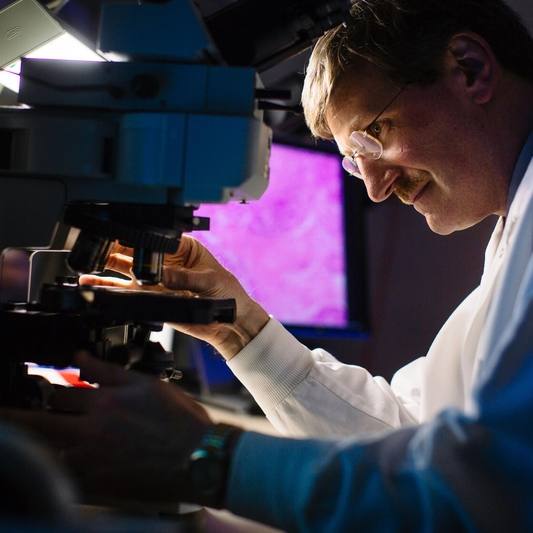-
Research
Potential Cancer Treatment Advance Using Ionic Liquid
February 10, 2021
Patients and their physicians have quite a few treatment options to sort through to manage hepatocellular carcinoma, the most common form of liver cancer. Now, thanks to an innovative new agent, one of those options may have a makeover in its future.
Physician-scientists from Mayo Clinic, in collaboration with Harvard University, report in Science Translational Medicine that they were able to uniformly distribute a chemotherapy drug in preclinical models into liver tumors and other solid tumors. This potentially solves a problem that has plagued ablation for cancer.
Choosing the right treatment for liver cancer depends on how big the tumors are, where they are, and a patient's overall health, among other factors. Generally, a liver transplant is considered the best option, but when a liver is not available, other treatments include drugs, surgery to remove the tumor, or targeted therapies to destroy cancer cells. Targeted therapies, also called local-regional therapy, are ones that use extreme heat or cold, radiation, or chemotherapy to destroy tumor cells.

Hepatocellular carcinoma, a common primary liver tumor linked to infections, exposure to aflatoxin or underlying disease, is rare in the U.S., according to the National Organization for Rare Disorders.
"Local-regional therapy for liver tumors remains a cornerstone of our therapeutic resources," says Gregory Gores, M.D., Kinney Executive Dean for Research at Mayo, and an expert in hepatobiliary malignancies. "Although a variety of biophysical approaches have been developed to kill tumor cells, to date a mechanism to deliver drugs in a uniform and predictable manner via these percutaneous approaches has not been achieved."
These targeted therapies, used to bridge a patient from diagnosis to transplantation, are limited to certain areas of the liver — for example, places away from other structures that could be injured, like the gallbladder. Another problem with liquid chemotherapy agents is that they may not saturate the tumor, thereby missing some cancer cells and paving the way for recurrence.
"No matter how you deliver the drugs today, they wash away. They fail to uniformly distribute. This is the Achilles' heel of cancer treatment," says Rahmi Oklu, M.D., Ph.D, a vascular and interventional radiologist at Mayo Clinic and senior author on the paper. This is true not just for liver cancer treatment, but also for tumors in general. But Dr. Oklu, who is the founder and director of the Minimally Invasive Therapeutics Laboratory at Mayo Clinic in Arizona, has developed a potential fix.

The substance is called an ionic liquid, which is a type of electrically charged fluid ― a salt in a liquid state. Ionic liquids are thick, syrupy fluids that conduct electricity and do not evaporate. They have numerus industrial applications and emerging biomedical applications.
The team combined chemotherapy drugs with an ionic liquid containing a blend of chemicals, including choline and geranic acid. Choline is a positively charged nutrient that the body connects with other chemicals to make, for example, phosphatidylcholine in cell membranes or the neurotransmitter, acetylcholine. Geranic acid is a chemical compound used commercially for its citrus scent. Together, choline and geranic acid have been used medically in ionic liquids to treat fungal or bacterial infections on the skin.
Dr. Oklu first heard of this combination at a talk given by Samir Mitragotri, Ph.D., of Harvard University. Dr. Mitragotri was using ionic liquid to deliver insulin through the skin. Intrigued by this observation, Dr. Oklu began testing different formulations of the substance in preclinical cancer models.
Dr. Oklu thought of liver cancer right away because it's difficult to punch through the cell membrane and the dense connective tissue of these tumors. And it's important that these tumors are treated.

"If you don't treat these tumors, then the patients can fall off the transplant criteria, so they can't get a transplant," Dr. Oklu says. "You could do microwave ablation and basically burn the tumor, but you can't do it next to the heart or other important structures, and it depends on the number and location of the tumors. There's also cost and physician expertise that can lead to problems. So we think this can replace some of that need with a potentially less expensive, less challenging ultrasound-guided needle injection."
In the paper, the authors report that they were able to consistently ablate and distribute a chemotherapy drug uniformly throughout human tumors of different origins, as well as liver tumors in animal models. The drug spread circumferentially, encircling the tumor and remaining in the ablation zone for the length of the 28-day trial. In current therapy, Dr. Oklu says, the drugs often wash away fairly quickly. The ionic liquid, which the authors call a "locally active agent for tumor treatment and eradication," or LATTE, also encouraged immune cells to infiltrate the microenvironment of the tumor.
After reading the article, Dr. Gores, who was not involved in the research, noted, "Not only does the ionic liquid permeate the tumor rapidly and effectively, but it also facilitates entry of the drug into the tumor cells. LATTE was quite effective in destroying tumors in preclinical models, and this approach also appears to promote an immunogenic cell death accompanied by inflammation, raising the possibility that LATTE may be synergistic with immunotherapy approaches."

In their paper, the authors suggest that LATTE may work via diverse methods. Future studies are planned to expand on these preclinical findings. These studies may examine additional chemotherapy drugs, effects of immunotherapy agents and effect on overall survival, as well as a detailed analysis of local and systemic immune implications of this experimental intervention.
Other than Dr. Oklu, Mayo Clinic authors are first author Hassan Albadawi, M.D.; Zefu Zhang, M.D.; Izzet Altun, M.D.; Jingjie Hu, Ph.D.; and Leila Jamal. From Harvard University, authors are Kelly Ibsen, Ph.D.; Eden Tanner, Ph.D.; and Dr. Mitragotri.
This study was funded by the National Institutes of Health. Drs. Oklu, Albadawi and Mitragotri declared that they are inventors on a patent application submitted by Mayo Clinic that covers LATTE and its applications. You can find a full list of disclosures in the paper.







